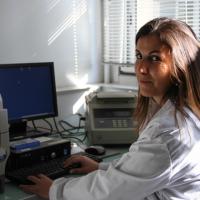
Bioeconomy Reading time 4 min
Julie Jimenez, the magic touch: turning garbage to gold
Published on 24 January 2017
A born math whiz, Julie earned a scientific baccalaureat and an undergraduate degree in mathematics before making her way to engineering school. In 2003, she enrolled in a master’s programme where learning about pollution piqued her curiosity. “In my classes on water and waste treatment, I realised that this is what I wanted to focus on” she says. “The biochemical transformation of organic material into something useful fascinated me”. She then went on to join the fourth year at INSA Toulouse for a final year of studies before graduating as an engineer in 2007.
Factoring in anaerobic digestion
From energy production...
The budding scientist quickly landed a job as a researcher for Veolia Environment in its research and innovation division at Maisons-Laffite. There, she focussed on water and residual sludge treatment to help sewage treatment plants generate energy, notably through the process of anaerobic digestion. “Anaerobic digestion is a series of biological reactions that spurs the breakdown of organic waste by bacteria and other micro-organisms. This bio-treatment produces methane and therefore heat and electricity”, explains Julie. “We worked on making this process the core activity at the waste treatment plant, and on integrating all possible flows in industrial digesters to keep waste treatment costs in check”. All the while, Julie pursed a doctoral degree on modelling this process. “I applied mathematics to biology to forecast the performance of energy production according to organic inputs. To do so, I characterised the inputs with an innovative method based on chemical fractioning analyses combined with 3D spectrofluorimetric analysis”.
A smart move: using waste to fertilise soil
... to sustainable organic waste management
To take things up a notch, Julie made the bold move of leaving Veolia in 2013 to pursue a post-doctoral degree at INRA’s Laboratory of Environmental Biotechnology (LBE). There, she was able to work on her thesis and broaden her scope to other processes and other types of waste: “I went from the treatment of sewage sludge to that of household and agricultural waste, combining composting and methanation. This was a different, much broader approach, and for the first time I was looking at the big picture, coming full circle back to the soil and putting final waste to good use as agricultural fertiliser”.
Indeed, what becomes of residual waste after energy production is a new frontier in research, and of particular interest to Julie, who joined the INRA team as a researcher in 2015. “Today, I am bridging the gap between recycled organic waste and the residue that is returned to the soil. The idea is to sidestep this residue from initial treatment, and to look first at what soil and agricultural systems need and define specifications for residue based on that. In other words, improve the process from its starting point. It’s what we call reverse engineering”, she explains.
- 34 years old
- 2000: Scientific baccalauréat
- 2001: Undergraduate degree, first year mathematics
- 2005: IUP (Institut université professionnel) Master’s in Industrial Systems Engineering
- 2007: Process Engineering degree (INSA)
- 2012: PhD in Process Engineering
- 2013-2015: Post-doctoral fellowship at INRA-LBE in Narbonne, INRA Montpellier
- Coordinator of the Ademe Concept-Dig project (2016-2019); Development of a tool to aid in the design and selection processes for the pre-treatment of digestates of agricultural methanation with a view for use in agricultural processes
- Author of ten publications in international journals
